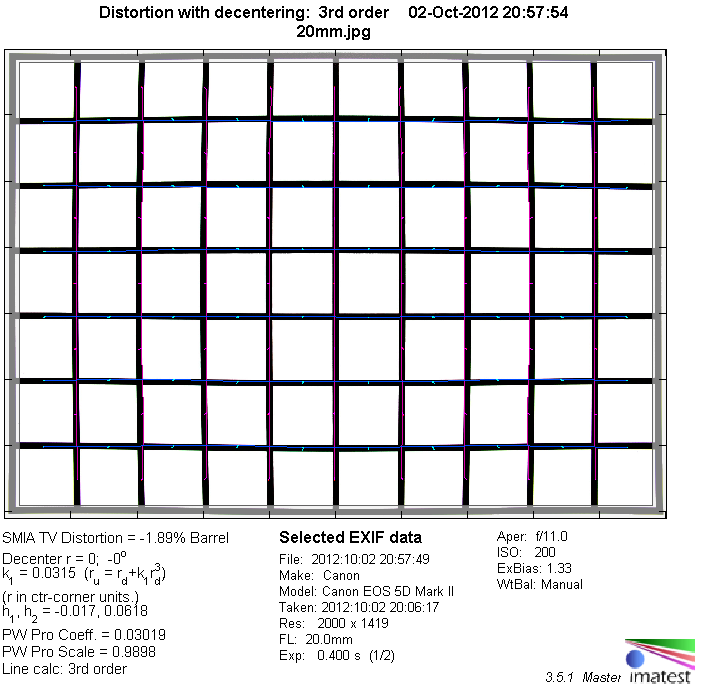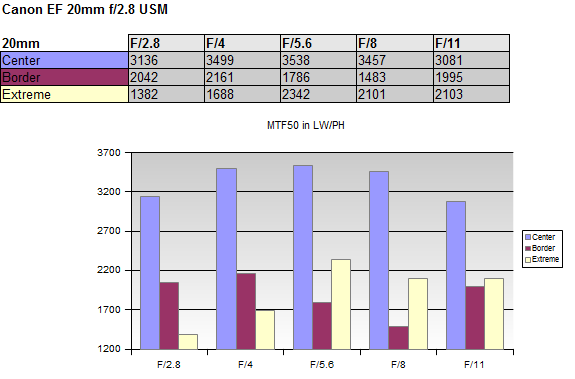|
Canon EF 20mm f/2.8 USM - Full Format Review / Test - Analysis |
|
Lens Reviews -
Canon EOS (APS-C)
|
|
Page 2 of 2

Distortion
The Canon lens produces only a very mild level of barrel distortion. Imatest (the software we use for the analysis) suggests a barrel distortion of ~1.9% but it is really less than that. The slight mustache-style sub-frequency may have confused the software a bit here.

Vignetting
Ultra-wide angle lenses have a difficult time on full format DSLRs but the EF 20mm f/2.8 USM has even more problems than usual in terms of vignetting. At f/2.8 it shows a rather extreme light falloff of more than 3.5EV (f-stops). You should stop down the lens to f/5.6 to tame the issue to a more or less acceptable degree although you will not be able to achieve a light falloff of less than 1EV.

MTF (resolution)
The resolution characteristic of the Canon lens is somewhat difficult - more on this in the next chapter. Now when measuring the quality on the focal field it is decent albeit not stellar. The center performance is certainly very fine even at f/2.8 and there's nothing wrong about the borders either but the corners are very soft at large aperture settings. Stopping down to at least f/5.6 is therefore highly advisable. The peak performance is reached at f/8 with a very good performance across the frame. Diffraction reduces the potential resolution from f/11 onward again - this is a physical limitation.
The tested sample had a good centering quality.
Please note that the MTF results are not directly comparable across the different systems!
Below is a simplified summary of the formal findings. The chart shows line widths per picture height (LW/PH) which can be taken as a measure for sharpness.
If you want to know more about the MTF50 figures you may check out the corresponding Imatest Explanations
Field Curvature
Things are rarely as simple as they appear and this is especially true for the EF 20mm f/2.8 USM. The resolution may be fine but the lens suffers from a rather massive amount of field curvature - thus it has a "curved" focus field rather than a perfectly flat one. Just as an hypothetical example - imagine the center focus point to be at -say- 2m whereas the corners have their focus hot spot at -say- 10m (at a set focus distance of 2m).
The chart below illustrates the MTFs on a flat plane rather than on the focus field. You may notice that the difference compared to the MTF chart above is actually not THAT different at f/2.8 and f/4 but things get pretty wild beyond.
So what can you do about it if you want to have a maximum depth-of-field and sharp corners ? Well, the situation is never really optimal but you could actually pull the focus towards you. This will also pull the borders into focus - just make sure that you don't overdo it because otherwise you will loose too much depth of field in the center of the image. You should also stop down to at least f/8 or f/11.

Chromatic Aberrations (CAs)
Lateral CAs (color shadows at the image borders) stay around an average pixel width of 1px at the image borders. This is pretty good for an ultra-wide angle lens actually.

Verdict
The Canon EF 20mm f/2.8 USM is not a bad lens but it shows that its design dates back to the early 90s. The technical resolution is actually pretty good with a very sharp image center and pretty good borders. The corners are also very decent at medium aperture settings. However, the lens suffers from a high degree of field curvature unless you adjust your shooting style you will end with relatively soft outer image region. The amount of vignetting at f/2.8 and f/4 is another weak spot although this is not unheard of from other ultra-wide angle lenses. On the positive side there's only a low amount of barrel distortion and lateral CAs aren't really disturbing either.
There's nothing wrong about the mechanical quality of this Canon lens. The lens body is made of plastic but there's no wobbling whatsoever and the constant physical length and internal focusing are still state of the art. The ring-type USM AF drive leaves nothing to be desired as well.
There are surely worse lenses than the Canon EF 20mm f/2.8 USM but the truth is that you are better off with the Canon EF 17-40mm f/4 USM L although you sacrifice a bit of speed here.
| Optical Quality: |
 (downgraded due to field curvature) (downgraded due to field curvature) |
|
|
| Mechanical Quality: |  |
| Price/Performance: |  |
| | |
| | What does this mean ? |
|